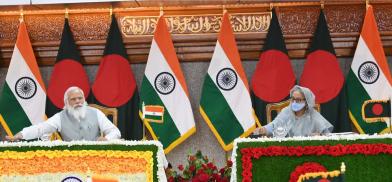Modi visit to Bangladesh: A new turn to South Asia's complex geopolitics
The leadership on both sides has ushered a new chapter in India-Bangladesh relations. India is well-positioned geographically and industrially to play the role of a near-shore partner for its allies like Bangladesh, writes Dr Indu Saxena for South Asia Monitor

India and Bangladesh's "360-degree partnership" could be a potent power diplomacy to change the South Asian security dynamics with economic boost by cornering the extremists and expansionists in the region. Indian Prime Minister Narendra Modi's visit to Bangladesh on March 26-27 is a key pillar in India's Extended Neighbourhood Policy and Act East Policy.
Now the time has arrived, when India's narrative of geopolitical power and call to defeat expansionism in the region is getting stronger.
Bangladesh is celebrating its 50th year as an independent country and the centenary of its founding father Bangbandhu Sheikh Mujibur Rahman. On this occasion, Prime Minister Modi's recent visit to Bangladesh will bring a new flavor to mutual relations and, of course, in the region's geopolitics.
Historic bonding
Half a century ago, Bangladesh appeared on the world map with a dark history of torment, killings, horror and genocide.
India had taken a bold step ignoring international pressure as it played the role of a friend and a well-wisher neighbour as also the protector of peace and human rights during the Bangladesh War of Liberation in 1971.
This bonding has continued for decades, with people of Bangladesh always recalling India's unconditional support against Pakistan's oppression.
India's military and Bangbandhu's Muktivahini (liberation army) fought together for the sake of Bengali autonomy. An estimated 300,000 and 3,000,000 civilians were killed in Bangladesh, and eight to ten million people fled the country and took shelter in India.
India's bonding with Bangladesh is deep. Both the countries share the same history, cultural heritage, language, art, literature, and music. India and Bangladesh are connected by geography and true friendship, which started with the birth of Bangladesh.
A sometimes bumpy ride
Despite the sometimes bumpy ride in their bilateral ties, the two nations have built close political, economic, trade, and cultural relations.
Bangladesh's Sheikh Hasina government has shown great eagerness to bolster the ties. The Indian government's efforts in implementing the Land Boundary Agreement in 2015 and accepting the international tribunal verdict over the 40 years old maritime dispute built trust in bilateral relations.
However, there are some issues like the Teesta water dispute, the killing of Bangladeshi civilians by Border Security Force (BSF), discrimination with Hindus in Bangladesh, and dubiety towards Citizenship Amendment Act (CAA) that need to be resolved for a better future in the friendship.
Religious radicalization and fundamentalism in Bangladesh is also a big challenge to tackle. This challenge grows more whenever the Bangladesh Nationalist Party (BNP) comes to power.
However, Bangladesh has come into being through Pakistan’s dismemberment and thus is fully aware that religious extremism can't hold a country together and only derails economic growth. Although the Sheikh Hasina government has made efforts to curb Bangladesh's fundamentalist movement, Islam is a significant factor in Bangladesh's politics.
During the recent meeting, the two leaders signed five Memorandum of Understanding (MoU) in connectivity, commerce, information technology, and sports. In a humanitarian gesture, Modi gifted 109 ambulances and 1.2 million Covid vaccine doses to Bangladesh.
It is worth mentioning that India has received big cheers for its "Vaccine Maitri" (vaccine friendship) project worldwide. However, the critics have been relating this visit to the assembly election in the border state of West Bengal and Hindu-Muslim politics. The critics are also pointing to the violence unleashed by Islamic radicals and students of madrassas opposing Modi’s visit.
Despite this myopic view, the Modi-Hasina meeting will have far-reaching implications in bilateral relations.
Roadmap for deeper bonding
Hence, Modi's trip to Bangladesh during a landmark year of the latter’s history has multiple political messages.
The experts can analyse it in three ways: first, the sentimental factor. Prime Minister Modi's presence at the golden jubilee celebration of Bangladesh's independence showed the friendship between the two neighbours is based on by mutual trust and mutual respect. It's also a reminder of India's pivotal role in the formation of Bangladesh. It has also sent a message to India's adversaries that New Delhi stands against extremism, oppression, and aggression and is a true facilitator in propagation of democracy.
Second, Bangladesh's geographical location in the Bay of Bengal area has greater significance, especially after the stirring Indo-Pacific politics. Indo-Pacific power contestation has begun at a bigger scale, particularly after Quad's (US, India, Australia, and Japan) top leaders met on March 12.
India is also looking to expand its maritime affairs, with Bangladesh, viewing China's assertiveness in the region, the Myanmar-China oil and gas pipelines.
Bangladesh could be an amicable gateway for India to Southeast Asian nations. It was clear during the previous visit of India's external affairs minister S. Jaishanker to Bangladesh when he stated, "We see Bangladesh as a key neighbour and a valued partner not only in South Asia but also in the broader Indo-Pacific region. Every outcome and achievement in our relationship resonates through this region".
Third, economically speaking, Bangladesh is the second-largest economy in the subcontinent with approximately $ 338 billion, and the figure is projected to go up to $ 488 in 2025. Bangladesh's per capita gross domestic product (GDP) is relatively high, and experts say it could surpass India.
Bangladesh has become an exporting hub due to its textile industry which has been generating billions in export. Bangladesh is the second-largest apparel manufacturing county in the world after China and plans to become middle-income country by 2021.
Bangladesh could seize more markets due to its lower production cost than China. India could assist Bangladesh in technology and other requirements. If India and Bangladesh increase their production in textile and readymade garments, that could speed up the economic growth engine for both countries. The conducive environment would lure foreign investment.
Colossal potential
The leadership on both sides has ushered a new chapter in India-Bangladesh relations. India is well positioned geographically and industrially to play the role of a near-shore partner for its allies like Bangladesh.
The paradigm has possibilities in multiple areas like technology transfer and sharing, six sigma and lean processes and optimal processes for extraction and consumption of resources.
Bangladesh’s intent of emerging as a progressive and developed nation in South Asia can be well complemented by the Indian expertise in industrialisation and social welfare.
This is a unique opportunity for India and Bangladesh to better align and benefit from the demographic dividend of the region. Inclusive growth and opportunities will be a key factor in channelising the energy of the growing young communities. The recent announcements of scholarships and entrepreneurial exposures are positive initiatives in this direction.
India and Bangladesh can work together to make sure the region utilises the resources efficiently as per their individual competencies to prevent livelihood migration. The maritime consolidation of the two neighbours will be a potent security strategy for the Bay of Bengal.
Lastly but importantly, India and Bangladesh can work together on clean energy and climate initiatives.
It is a very progressive moment for bilateral ties and the geopolitics of South Asia. Despite the challenges, there is the colossal potential to work together to achieve their national and regional interests too.
(The author is Senior Writer at the Consortium of Indo-Pacific Researchers. Views are personal. She can be contacted at is408@scarletmail.rutgers.edu. She tweets @Indu0109.)
Do you have any? Kindly allow me know so
that I could subscribe. Thanks.










Post a Comment